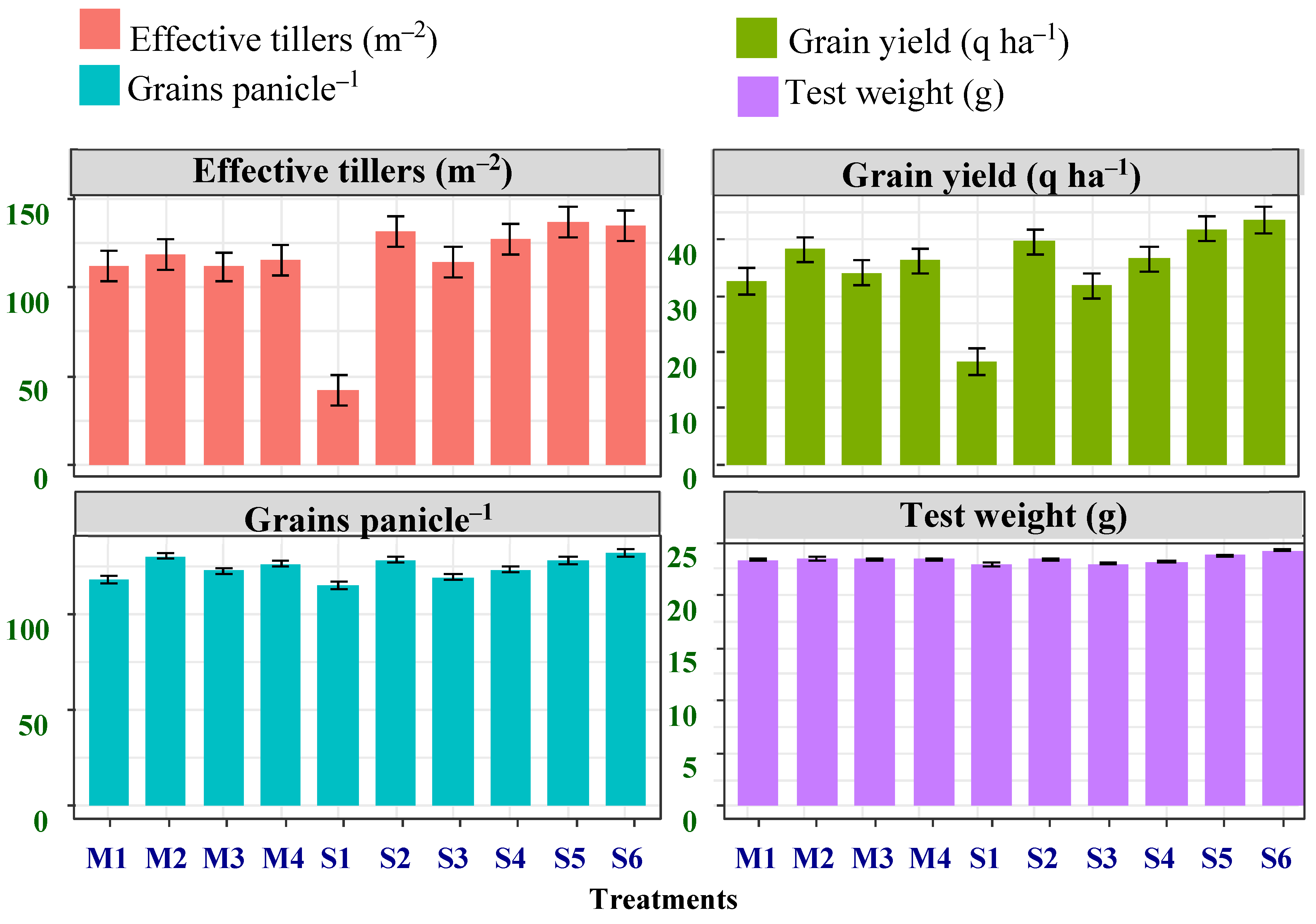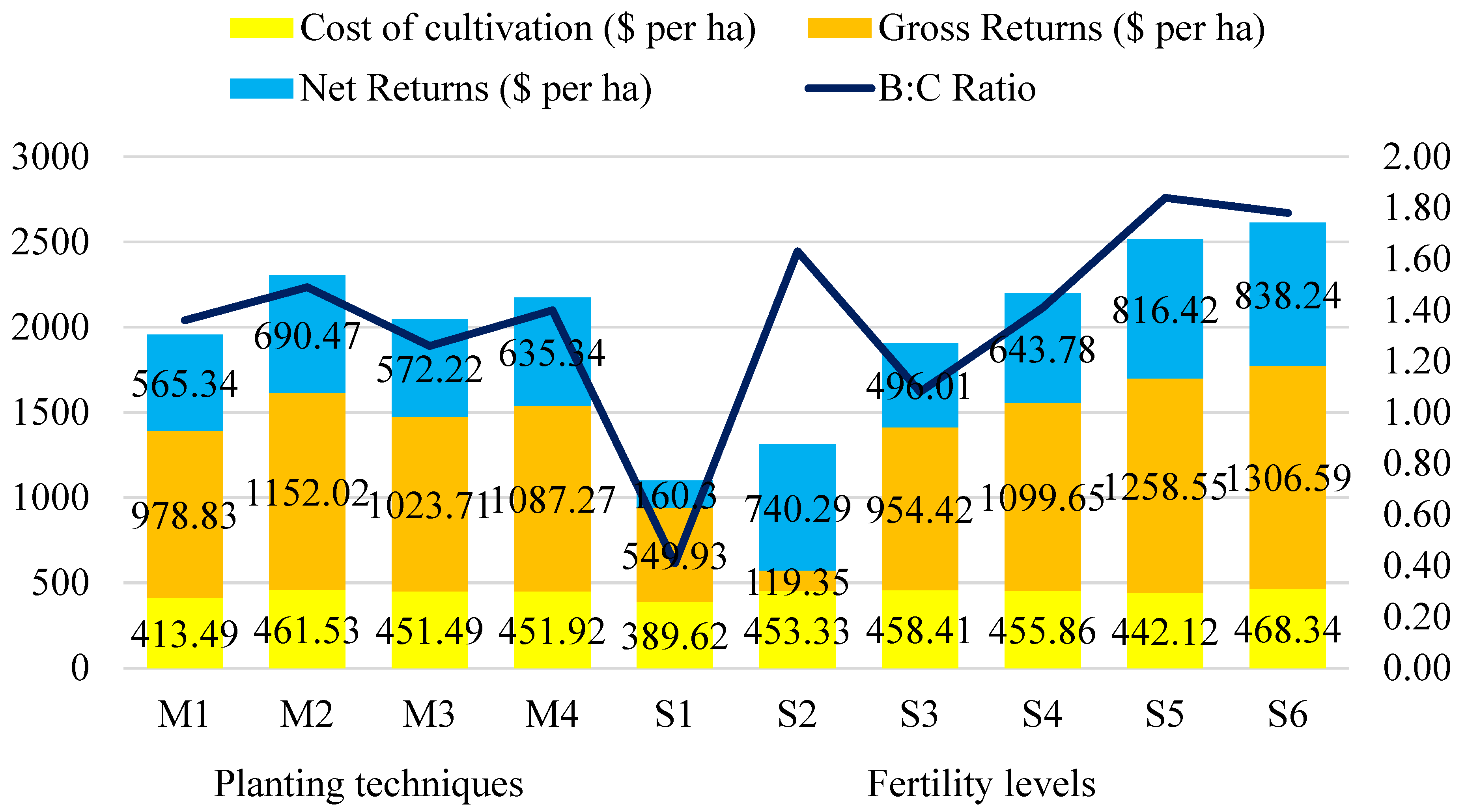1. Introduction
India, as the world’s second-largest producer and consumer of rice, plays a significant role in global agriculture. With a vast cultivation area of 43.77 million hectares, the country yields 112.76 million tonnes of rice. Uttar Pradesh (India), a leading state in rice production, contributes substantially, with 5.86 million hectares under cultivation and a remarkable yield of 15.54 million tonnes per hectare (2018-19 report of the Directorate of Economics and Statistics). For sustainable rice production, maintaining soil health and enhancing crop productivity are pivotal. Conservation tillage, aiming to minimize soil disturbance and erosion, proves beneficial by promoting better soil structure, moisture retention and nutrient availability. Raised beds with furrow irrigation, an efficient water-distribution method, help maintain an optimal soil moisture balance. Additionally, the practice of Unpuddled Transplanted rice, which conserves water and energy while enhancing nutrient uptake efficiency, has emerged as a promising alternative.
Integrated Nutrient Management (INM) serves as a critical component in this pursuit. It combines organic and inorganic fertilizers tailored to the specific needs of the soil and crop. By integrating farmyard manure with judicious chemical fertilizer use, INM boosts soil fertility, microbial activity and overall soil health, leading to increased crop productivity. This approach not only reduces environmental pollution, but also enhances the sustainability of rice production systems [
1].
2. Material and Methods
This field experiment was conducted at Sardar Vallabhbhai Patel University of Agriculture and Technology, Meerut (Uttar Pradesh, India), during the kharif season (June–September) in 2019. It was laid out in a split-plot design with three replications. The treatments comprised four planting techniques (viz. M1—Reduced Tillage Transplanted Rice (RT-TPR), M2—Conventional Tillage Transplanted Rice (CT-TPR), M3—Furrow-Irrigated Raised Beds (FIRB), M4—Unpuddled Transplanted Rice (UP-TPR)) as the main plot treatments, and six fertility levels (viz. S1—Control, S2—100% NPK Chemical fertilizer, S3—100% N (FYM), S4—50% NPK + 50% N (FYM), S5—75% NPK + 25% N (FYM), S6—100% NPK + 25% N (FYM)) as subplot treatments, and rice variety PB1 was tested. The soil of the experimental site was low in organic carbon (0.42%), nitrogen (195.3 kg ha−1), had a medium amount of available phosphorus (12.4 kg ha−1) and available potassium (118.2 kg ha−1) and was alkaline in the reaction. The data collected from the experiment were analyzed statistically by the analysis of variance (ANOVA) method for the split-plot design, with planting techniques and fertility levels as the main and sub-factors, respectively. Whenever the treatment differences were found to be significant (F test), critical differences were worked out at a five percent probability level.
3. Yield and Yield Attributes
3.1. Number of Effective Tillers m−2
Using a quadrat of one square metre in each plot, shoots bearing panicles at the time of harvesting were counted in accordance with the process used for counting the number of tillers at each succeeding stage, which is referred to as the number of panicles m−2.
3.2. Number of Grains Panicle−1
The number of grains panicle−1 was counted on the panicles chosen for measuring length. By threshing the grains, the number of filled and empty grains was counted, and the average number of grains per panicle was calculated.
3.3. Test Weight (g)
After threshing and cleaning, a handful of seeds were randomly selected from the total seeds of the net plot. Each plot sample had 1000 filled grains counted and weighed on an electronic scale, and their weight was reported in grams.
3.4. Grain Yield (q ha−1)
The grain yield was measured in kg per plot after the grains had been cleaned and dried. Using a moisture metre, the moisture percentage in 100 g samples taken from each treatment was calculated, and the grain yield per plot was adjusted to 14% moisture. The yield of the net plot is expressed as q ha−1.
3.5. Economic Analysis
3.5.1. Cost of Cultivation (USD per ha)
The cost of rice crop production was determined using the local market price of various inputs utilized in cultivation and is expressed as USD per ha.
3.5.2. Gross Return (USD per ha)
The yield of grains and straw was valued in USD (all economics parameters were calculated as Indian rupees and converted into USD by using the exchange rate of USD) using the current output price on the local market. The gross return was calculated as USD per ha and acquired by summing the monetary values of the grain and straw.
3.5.3. Net Return (USD per ha)
The net return was computed by taking the cost of cultivation out of each treatment’s gross return.
3.5.4. Benefit–Cost Ratio (B:C Ratio)
The following formula was used to obtain the benefit–cost ratio:
4. Statistical Analysis
One-way analysis of variance (ANOVA) was used to compare the differences in soil characteristics across treatments, and the least significant difference test was then performed. A difference was deemed statistically significant if it was present at the p 0.05 level. The impacts of planting methods and soil fertility levels were studied using a two-way ANOVA. With the help of the online statistical tool OPSTAT, statistical analysis was carried out.
5. Results and Discussion
5.1. Crop Productivity
The planting techniques and fertility levels significantly influenced the yield and yield attributes of rice (
Figure 1). The Conventional Tillage (M2) treatment displayed the highest number of effective tillers m
−2 and the most grains panicle
−1. This might be because conventional tillage fosters the growth and development of rice plants, leading to increased tillering and grains panicle
−1, thereby enhancing the potential yield. In contrast, the Reduced Tillage (M1) treatment exhibited the fewest effective tillers m
−2 and the most grains panicle
−1. This might be due to reduced soil disturbance and potential resource competition among plants in this treatment. The Furrow-Irrigated Raised Bed (M3) and Unpuddled (M4) treatments resulted intermediate results in terms of effective tillers m
−2 and the most grains panicles
−1. The Furrow-Irrigated Raised Bed method, involving raised beds with irrigation furrows, could have influenced root development and resource utilization. The Unpuddled approach, where soil is not puddled before transplanting, possibly struck a balance between reduced tillering and enhanced resource availability. Notably, there were no significant differences observed in test weight among the planting techniques. Similar results were reported by [
2], indicating consistency in the outcomes of these experiments.
Treatment S5 (75 percent NPK + 25 percent N from FYM) had the largest number of effective tillers m
−2 and the most grains panicle
−1 among fertility levels. This shows that a well-balanced mix of chemical fertilizers and organic sources (FYM) can greatly boost rice production potential. In terms of effective tillers m
−2 and the most grains panicle
−1 and grain production, the Control (S1) treatment with no fertilizers had the lowest results. The presence of organic matter most likely enhances soil microbial activity by gradually releasing nutrients, which, when paired with chemical fertilizers, leads to enhanced tillering and grain development, resulting in a greater grain yield. Similar findings reported by [
3].
5.2. Crop Profitability
Economics
The planting techniques significantly influenced the economic aspects (
Figure 2) of rice cultivation. Among the planting techniques, M2 (CT-TPR) resulted in the highest gross returns (USD 1152 per ha) and net returns (USD 690.48 per ha), with a B:C ratio of 1.5.
This result is consistent with the findings in the yield attributes section, where Conventional Tillage also showed higher grain yield, effective tillers and grains per panicle. The increased yields under this technique likely contributed to the higher economic returns. Treatments M1 (RT-TPR) and M4 (Unpuddled TPR) also exhibited promising results, yielding net returns of USD 565.34 per ha and USD 635.34 per ha, respectively, with B:C ratios of 1.37 and 1.41. M3 (FIRB-TPR) showed slightly lower net returns (USD 572.22 per ha), with a B:C ratio of 1.27. Fertility levels also played a crucial role in determining the economic outcomes of rice cultivation. Treatment S6 (100% NPK + 25% N(FYM)) had the highest gross returns of USD 1306.59 per ha and net returns of USD 838.25 per ha, resulting in a B:C ratio of 1.79. This was closely followed by S5 (75% NPK + 25% N (FYM)), with the second-highest gross returns (USD 1258.56 per ha) and net returns (USD 816.43 per ha) among all fertility levels, with an impressive B:C ratio of 1.85.
Treatments S4 (50% NPK + 50% N (FYM)) and S2 (100% NPK Chemical fertilizer) also performed well, yielding net returns of USD 643.79 per ha and USD 740.29 per ha, respectively, with B:C ratios of 1.41 and 1.63, respectively. S3 (100% N (FYM)) and S1 (Control) showed relatively lower net returns (USD 496.01 per ha and USD 160.31 per ha, respectively), with B:C ratios of 1.08 and 0.41, respectively.
6. Conclusions
The combination of Conventional Tillage with Transplanted rice and the use of chemical fertilizer alongside organic nitrogen from farmyard manure (FYM) proved to be the most successful in terms of enhancing key yield parameters.
Conventional Tillage Transplanted rice (M2) stood out prominently, yielding the highest gross returns and net returns due to its superior yield. Notably, the Reduced Tillage Transplanted rice (M1) and Unpuddled Transplanted rice (M4) techniques also demonstrated commendable performance. Among the various fertility levels, the 75% NPK + 25% N FYM (S5) approach led the way, generating the highest gross returns and net returns. The treatment with 100% NPK + 25% N from FYM (S6) also performed impressively, emphasizing the importance of synergizing chemical fertilizers and organic sources for optimal agricultural output. Crucially, all planting techniques (M1, M2, M3 and M4) exhibited benefit–cost ratios above 2.0, underscoring their economic viability. Similarly, all fertility levels (S1 to S6) showcased benefit–cost ratios above 1.4, confirming their profitability. These findings underline the significance of adopting specific planting techniques and balanced fertility approaches, offering valuable insights to farmers and agricultural practitioners aiming to maximize both yield and economic returns in rice cultivation.
Author Contributions
Writing—original draft preparation, investigation, data curation, G.N.K.; Conceptualization, methodology, supervision, P.K.S.; Review and editing, R.K.N. and M.S.C. All authors have read and agreed to the published version of the manuscript.
Funding
This research received no external funding.
Institutional Review Board Statement
Not applicable.
Informed Consent Statement
Not applicable.
Data Availability Statement
Data is available from the correspondent author upon reasonable request.
Conflicts of Interest
The authors declare no conflict of interest.
References
- Bhatt, M.K.; Labanya, R.; Joshi, H.C.; Nand, M. Effect of long-term inorganic and organic manure on physical and biological properties of soil in Uttarakhand-A review. ENVIS Bull. Himal. Ecol. 2019, 27, 49–54. [Google Scholar]
- Badshah, M.A.; Naimei, T.; Zou, Y.; Ibrahim, M.; Wang, K. Yield and tillering response of super hybrid rice Liangyoupeijiu to tillage and establishment methods. Crop J. 2014, 2, 9–86. [Google Scholar] [CrossRef]
- Dhaliwal, S.S.; Sharma, V.; Shukla, A.K.; Gupta, R.K.; Verma, V.; Kaur, M.; Behera, S.K.; Singh, P. Residual Effect of Organic and Inorganic Fertilizers on Growth, Yield and Nutrient Uptake in Wheat under a Basmati Rice–Wheat Cropping System in North-Western India. Agriculture 2023, 13, 556. [Google Scholar] [CrossRef]
| Disclaimer/Publisher’s Note: The statements, opinions and data contained in all publications are solely those of the individual author(s) and contributor(s) and not of MDPI and/or the editor(s). MDPI and/or the editor(s) disclaim responsibility for any injury to people or property resulting from any ideas, methods, instructions or products referred to in the content. |
© 2023 by the authors. Licensee MDPI, Basel, Switzerland. This article is an open access article distributed under the terms and conditions of the Creative Commons Attribution (CC BY) license (https://creativecommons.org/licenses/by/4.0/).









